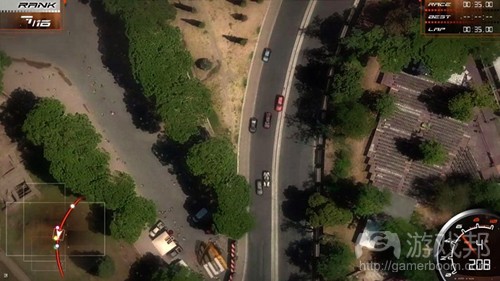开发者探讨如何在游戏中植入真实世界场景
作者:Mike Rose
我着迷于采用真实世界场景的电子游戏。每当某个开发商声明“你将在我最新出炉的游戏中探索真实的城市与地标建筑物”时,我立马对该作品抱以关注与好奇态度。
虽然用户创造的世界会很有趣,然而,采用真实场景意味着你可能会在使用这一元素时受到某些限制。使用著名的地标建筑可能十分酷派,但实际上,当你需要进行某些调整时,结果并不那么可观。
由于《Real World Racing》将于今年第四季度发售,所以开发者有充分的时间解决这些问题。该作是一款类似《Micro Machines》系列的上下视角竞速游戏,但其更加注重逼真的物理效果,而且更重要的是,你将在真实世界的地点中进行比赛。
实际上,开发团队Playstos Entertainment并未单纯基于真实世界制作这款游戏。该工作室在游戏总直接融合诸如罗马、巴黎、伦敦以及柏林这些城市具有高分辨率的航拍图片,创造出高度逼真,十分接近真实世界的环境。
程序员主管Ivan Del Duca解释道:“实际上,我们是个小型开发团队,其中只有两位美工可以发挥作用,因此为了尽可能减少他们的工作量,游戏的大部分内容与题材只能采用天然元素。”
同时,该团队还认识到,之前还未有哪个开发商在竞速游戏中采用真实的航拍图片,因此Playstos的这款游戏能够完全称为原创作品。
他还解释道:“目前,从上下视角制作竞速游戏并不盛行,采用真实世界图片更能突显该作的优势,而且也不会被当作由低成本打造的另一款上下视角的竞速游戏。”
我询问Del Duca道,由于不同寻常的美丽外观,他是如何确保《Real World Racing》并不只是拥有美丽的外壳。他的团队是否发现制作充满乐趣的真实世界实际上十分棘手?
他承认道:“坦白讲,我们确实遇到了困难。我们不得不在环形跑道的运行区域上进行让步,偶尔会稍加修改游戏环境。有时我们根本无从下手。”
他解释道:“最典型的莫过于设置每场比赛的发生时间:有些图像无法简单地转换为令人信服的夜晚,甚至是阳光普照的正午。同样地,我们还需解决建筑物分散在城市各个角落这一问题:我们可以避免横穿其中的某些建筑物,而有些则会包含在画面中。”
为此,他们该如何选择游戏中应包含真实世界的哪些部分呢?
Del Duca表示:“其实,答案比预期的更加简单,但你却无法想到其中原因。我们浏览了大量来自世界各地城市的航拍图片,我们自认为这些图片最有可能被列入选择行列,而后我们发现,采用高质量的材料并非我们预想中的简单。”
“最终,我们发现自己选择了那些看起来还不错的地点,摒弃了其余材料。因为更加具体的图片有利于我们研究的城市,因此我们会在游戏中对它们做出一些调整。”
由于在竞速游戏中植入航拍图片是个创新理念,所以除了该工作室如何正确实现这一举措外,我十分好奇采取这种做法的法律后果。如你所料,Playstos不能免费使用这些图片,他们已经购买了这些作品的使用权。Del Duca指出:“实际上,购买这些权限所需的费用占据了《Real World Racing》开发成本的一大部分。”
除此以外,在游戏中植入图片也是一项深度的任务。Del Duca解释道:“在此,我们利用内部开发的引擎,不断下载当前大型且高品质的城市图片。”
“我们使用Photoshop,在汽车途经的跑道区域中清除了交通工具、人物以及其它瑕疵。移除了会封闭汽车通过道路的物品和阴影。接着,我们利用专门技术与编辑能力,赋予这些建筑物、树木、以及高架桥这类建筑逼真的3D效果。”
从游戏预告片可看出,赋予游戏场景正确的角度还需要一段时间,即使该作只采用简单的2D效果。然而,有些3D模型,比如障碍、轮胎与及其它附加装饰物已添加到其中以助达到相应效果。(本文为游戏邦/gamerboom.com编译,拒绝任何不保留版权的转载,如需转载请联系:游戏邦)
Reality has nice graphics, but making it fun requires a few tweaks
by Mike Rose
I’m fascinated by the use of real-world locations in video games. Whenever a developer states that you’ll be exploring real cities and landmarks in its latest upcoming game, I instantly become both wary and intrigued in equal measure.
This is, of course, because user-created worlds are built purposely to create as much fun as possible, whereas using the real world means that you potentially have restrictions on what you can do with it. Using famous landmarks may seem cool, but when it comes to actually giving it a whirl, the results are often not so exciting.
Real World Racing, due for release in Q4, has been tackling these issues daily. The game is a top-down racing game in the same vein as the Micro Machines series, but with realistic physics and realism in mind — and more importantly, you race around real world locations.
In fact, development team Playstos Entertainment took it a step further than simply basing the game in the real world. The studio took high resolution aerial photographic images of such cities as Rome, Paris, London and Berlin, and merged them directly into the game, creating a highly believable environment that is point-for-point similar to our world — well, except where the team has fiddled with it in the name of fun.
“Our team is really small, with only a couple of artists steadily available, so the choice to have most of the contents and style ready with as little contributions as possible seemed only natural,” explains lead programmer Ivan Del Duca.
His team also realized that no-one had attempted to use real aerial photos before in a racer, so Playstos would have something completely original on its hands.
He also notes that “from the perspective of creating a top-down racer, a sub-genre that isn’t currently enjoying much popularity, using real world imagery looked like a good way for the game to be noticed for its own merits and not just shunned as another low budget top-down racer.”
Niceties out of the way, I question Del Duca regarding how he is going about making sure Real World Racing isn’t just a pretty face. Has his team found that making the real world actually fun is tricky?
“I won’t lie, we definitely did,” he admits. “We had to compromise on where the circuits would run and slightly rework environments on occasion. At other times we found that there were adaptations we couldn’t make at all.”
“A prime example would be the time of day at which each race takes place: some imagery simply couldn’t be adapted to receive a credible evening, or even noon sunny lighting,” he notes. “Another similar problem is the presence of a number of construction sites scattered around every corner of any given city: some we could avoid running along, while some other we had to include.”
So how, then, did the team go about choosing which parts of the real world to include in the game?
“It’s actually simpler than you would expect, but not for the reasons you would imagine,” he tells us. “We sifted through a lot of aerial imagery from cities around the world that we thought would be popular choices, and finding material of high enough quality proved more difficult than expected.”
“Eventually we found ourselves picking our locations based on what looked good enough, discarding the rest. As more detailed imagery becomes available for the cities we looked into, we will update and add them to the game.”
Since injecting aerial photos into a racing game is a new concept, I was intrigued to hear about the legal ramifications of the move, alongside how exactly the studio is making it work. As you’d expect, Playstos isn’t allowed to simply use these photos for free, and has already purchased licenses to use the imagery (in fact, these licences “amounted to the better part of the cost of developing Real World Racing,” says Del Duca.
On top of this, pulling the images into the game is a in-depth task. “At the base of the technology is our in-house developed engine that allows us to dynamically load the currently visible portions of the large, high quality textures of the city,” explains the lead programmer.
“The aerial imagery is cleaned up of traffic, people, and other imperfections with Photoshop wherever the tracks will run. Items that should occlude cars passing on the roads and shadows are also separated at this stage. Then, with our proprietary technology and editor, we add a realistic 3D effect to buildings, trees and other elevated structures starting from the 2D bitmaps without adding actual 3D models, which would look unrealistic and out of place.
As has been shown in the above teaser trailer, this process goes a long way to giving the game just that right amount of perspective, even when the game world is being based on simple 2D data. A few 3D models, like barriers, tires and additional decorations are added to help define the track, and finish off the effect.
Real World Racing is set to be released for PC in Q4 2012, with a Steam release hopefully on the cards. (source:gamasutra)
下一篇:游戏制作人需把握结果与过程的平衡









































